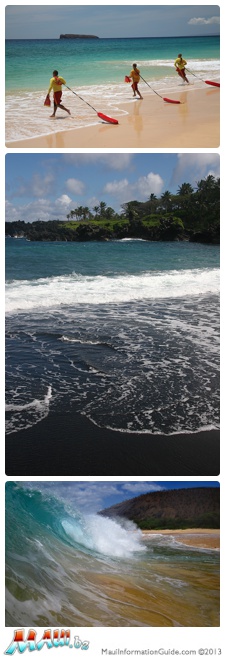Swimming in the ocean is one of the main reasons so many people come to Hawaii every year. However, if you’re not aware of the dangers of swimming in the ocean vs. a pool, you can put yourself (and others) in danger. Take a look at our top tips for ocean safety and remember, when in doubt, don’t go out!
 Do Not Swim Alone – No matter how good of a swimmer you are, it’s always safer to swim in groups.
Do Not Swim Alone – No matter how good of a swimmer you are, it’s always safer to swim in groups.- Know Your Limits – If you know you’re not a strong swimmer, avoid getting in the water when wind, currents, rip tides and waves are high. Watch other swimmers enter and exit the water for at least a few minutes to know what to expect. Set your expectations realistically on how well you can swim without the aid of floatation devices and never go out farther than you can swim.
- Ask a Lifeguard – Choose beaches that have lifeguard stations, and don’t be afraid to approach them to ask about conditions. Hazard warning signs are posted for dangerous shore breaks, strong currents, high surf, shark sightings, sudden drop-offs, waves breaking on ledges, jellyfish, man-o-war, sharp coral and slippery rocks.
- Be Cautious – Rip tides can drag even the strongest swimmers out into deep water. Rip currents are usually recognized by a sandy discoloration and smooth water between breaking waves. Since rip tides are in proportion to the frequency and size of the waves, the larger the waves, the stronger the rip currents will be. If you find yourself caught in a rip tide, do not swim against the current, but rather parallel to the shore, slowly working your way back at an angle. Do not panic and do not be afraid to signal for help.
- Be Aware – Just because the water looks calm doesn’t always mean it is. Waves come in sets, so be aware of the tidal cycles and possible marine life around you when entering the water. Avoid swimming at night, wearing shiny jewelry and do not swim in areas that are being fished.
- Have a Plan – Always have an entry and an exit plan from the water. Remember where you got in and try to follow a similar path. If a large wave is approaching and you don’t have time to get out of the way, try to dive beneath it or keep your body as low as possible until it passes over you. Waves breaking close to shore have caused thousands of neck and back injuries, so make sure to always keep an eye on what’s coming and have a plan on how to handle it. If you plan on surfing, make sure you watch other surfers and don’t overestimate your abilities in big waves.
- Follow the Basics – Wear sunscreen, bring appropriate footwear when visiting beaches with wet rocks and slopes, and avoid alcohol and drugs when swimming in the ocean. Never leave children unattended.
Maui beaches with lifeguards include:
- Kamaole I, II and III
- Hanakao’o Beach Park (aka Canoe Beach)
- Kanaha Beach Park
- Baldwin Beach Park
- Ho’okipa Beach Park
- Makena Beach (aka Big Beach)
Be aware, take the steps necessary to ensure your safety and enjoy your time in the water!

